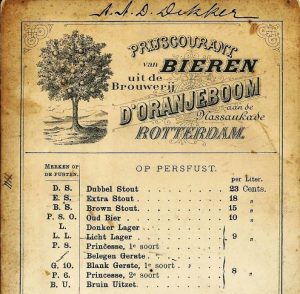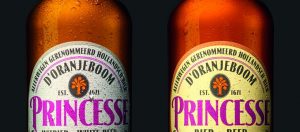38 Oranjeboom
 Introduction
Introduction
Established in 1671 by two Dutch entrepreneurs, Oranjeboom is a Dutch Lager with a unique past, and a promising future.
Since the 18th century, Oranjeboom was the first to export their beers all over the world, and almost 350 years later, this beer is now available in 90+ countries.
Origins

Originally one of the oldest breweries in the country, first starting with the merging of two breweries in Rotterdam, De Dissel and van den Oranjeboom. By 1885, Oranjeboom had one of the most sophisticated breweries in the Netherlands. This lager gets its name from an orange tree, which is a symbol of the Dutch royal family tree.
In 1972, Oranjeboom took their name off the Dutch market and had replaced it with the ‘international’ British brand Skol. Skol is a UK beer, with a Scandinavian name, that translates to “Toast”. This is the equivalent to our “Cheers”. It was used as a marketing tactic, and by 1982, when sales began to skyrocket, Oranjeboom was reintroduced.
By 1990, the brewery had closed and moved to Breda, Netherlands. Five years later, the brewery sold to Interbrew, and in 2004, the brewery had merged with a Brazilian brewer called AmBev, to form InBev. Today, this brewery is now called United Dutch Breweries. InBev continued to use the Oranjeboom brand, but a deal was made that the brand could not be used in its home country. In 2013, Oranjeboom was relaunched as a “quirky” new European style lager, and in 2015 Oranjeboom was finally allowed back on the Dutch market.
Key Milestones
Princesse Beer – The Original
Princesse beer is a style of beer that has been around since the 18th century, an entire century before India Pale Ale was introduced. This style of beer was first created as a tribute to Anna van Hannover, the Princess of Oranje-Nassau, the wife of Willem IV and daughter of King George, king of England.
When a more affordable lager-style bottom-fermented beers were easier to produce and introduced to the market, the top-fermented Princesse beers slowly began to disappear from the beer scene.

Oranjeboom was one of the original breweries to create this style of beer. Popular throughout the 19th century, this was a brown beer, with spices such as licorice root, coriander, and orange peel. Today this beer only exists in Holland.
A recipe from 1866, but not the recipe found on lostbeers.com:
PRINCESSE BEER.
For this beer one takes 56 pounds of brown malt, or equal parts of pale and brown malt, according to the colour desired, with 5 ounces [of 100 grams] of Flemish hops, 2 ounces of coriander fruits, 2 ounces of orange peel and 2 ounces of liquorice per tun [of 155 litres]. Evaporation 1/6 part of the quantity of water, yeast 3½ ounce, added to the brew at 12º [Celsius]. Top fermentation.
Timeline
1671 – Brewery was first established by two Dutch entrepreneurs in the city of Rotterdam.
1866 – Princesse style beer makes it’s appearance, becoming the most popular type of beer of the 19th century.
1885 – Oranjeboom has one of the best equipped and most modern breweries in the Netherlands.
1889 – Oranjeboom is now imported in countries such as Hong Kong, Singapore, the Dutch Indies (Present-day Indonesia), Egypt, Sweden, Germany, Spain and many more.
1900 – A Dutch-style beer called Princesse beer was created in honour of the House of Orange.
1950 – Oranjeboom becomes the leading Dutch beer in the UK.
1954 – Dutch beer is regarded highly by Americans. Oranjeboom is promoted with typical Dutch symbols to focus on its roots.
1972 – Oranjeboom takes their name off the Dutch market and replaced it with ‘international’ British brand Skol. During the Skol years, Oranjeboom was used as a brand for exporting.
1982 – After Skol sales plummeted, Oranjeboom’s name was reintroduced.
1990 – The brewery was closed and moved to Breda, located in North Brabant, Netherlands.
1995 – The brewery located in Breda was sold to Interbrew, a large Belgian brewing company.
2004 – Interbrew merged with a Brazilian brewer called AmBev, to form the brewery company InBev. The former export department, now called United Dutch Breweries, continues to use the Oranjeboom brand, but made a deal with InBev, that the brand could not be used in its home country.
2013 – Oranjeboom was relaunched as a quirky new European style lager.
2015 – Oranjeboom is allowed back on the Dutch market!
2019 – This ever-expanding beer is now appreciated in more than 90 countries all over the world. Except for Canada☹
Test your Oranjeboom knowledge!
Industrialization and Globalization
Brewing Science and Industrialization
By 1885 Oranjeboom had one of the best equipped and most modern breweries in all of the Netherlands. Today, this company values curiosity and are always looking for ways to expand their range of beers.
In the late 19th century, Oranjeboom‘s development in the Dutch brewing industry involved a then-new process of brewing lager, which used yeast and had the capability of cool-fermenting. This allowed for year-round production, but it also required a significant investment in modern technology and cold storage.
Fermenting Beer – Translated and foreword from Biernet
Around 1870, Bavarian beer, a new production method, had gained popularity in the Dutch brewing industry. Heineken became the first in the Netherlands to switch to the Bavarian production method. A year later, a man named Willem Baartz (who at the time, owned Oranjeboom) had made plans to set up a Bavarian beer brewery in Rotterdam. Heineken feared competition and contacted Baartz to make it a joint venture. Heineken Bierbrouwerij Maatschappij (HBM) established on January 11th, 1873, and another co-partner, Mr. Hoijer had joined in 1860, becoming one of the four directors. Willem Baartz became a supervisory director. A new brewery in Rotterdam was built on the Crooswijkschen Singel, which would only produce bottom-fermenting beer, while Oranjeboom continued to produce top-fermenting beer. However, in 1884, violent conflict broke out in HBM’s management when Oranjeboom considered purchasing a Linde ice machine (a refrigeration company)

This was needed in order to build a new brewery outside the city and improve the quality of the top-fermenting beers by arrangement and cold temperature. Oranjeboom started to build its own brewery for Bavarian beer in Oranjeboomstraat, South of Rotterdam, which took its name from the brewery. By 1885, this modern equipped company had production of top-fermented and bottom-fermented beer was put into use in South Rotterdam. The Coolvest location remained in use as a branch and storage facility until 1902.
Beer Styles
Oranjeboom is known for their Lager, but they also have a wide variety of beer styles for everyone. Here is a list of the beers that Oranjeboom carries around the world:
- Oranjeboom Premium Lager, Lager 5%
– Oranjeboom Premium Lager, Non-alcoholic 0%
– Oranjeboom Premium Lager 3.2, Light 3.2% - Oranjeboom Hopped Harbor, IPA 7.8%
- Oranjeboom White Waves, Craft Witbier 5.6%
- Oranjeboom Sailing South, Amber Ale 5.9%
- Oranjeboom Black Boats, Imperial Stout 7.5%
- Oranjeboom Premium Strong, Strong Lager
– Imported Extra Strong 8.5%
– Imported Super Strong 12%
– Imported Ultra Strong 14%
– Imported Mega Strong 16% - Oranjeboom Premium Radler, Radler 2.5%
- Oranjeboom Premium Cider, Cider 4.5%
- d’Oranjeboom*, Princesse Beer 5.6%
- d’Oranjeboom*, Princesse Whitebeer 5.6%
*As a clever move, Oranjeboom put the orginal d-apostrophe, which used to be in front of Oranjeboom name for centuries, a way to distinguish the historical craft beer d’Oranjeboom from the plain lager by Oranjeboom. (foreword by http://lostbeers.com/princesse-beer-by-doranjeboom/)
Princesse Beer
As mentioned before, Princesse beer started as an export beer for long distances by sea and has been around since the 18th century. This was an entire century before IPA (India Pale Ale) was introduced to the world. Named after the Princess of Oranje-Nassau, Anna van Hannover, the wife of Willem IV and was also the daughter of King George, the King of England. This beer slowly began disappearing from the beer scene once a more affordable lager-style bottom-fermented beers were easier to produce.

Princesse beer is a traditional Ale, that is enjoyed with foods such as roasted meat, roasted chicken and French cheese. Has the combination of licorice, coriander, and Curaçao (a descendant of the bitter orange), with a bit of a spicy flavour. Made with Munich malt, Hallertauer Magnum Hops & Tettnanger Hops.
Characteristics
ABV – 5.6%
EBU (European Bitterness Units) – 30
IBU (International Bitterness Units) – 35
Glassware best to used is a dimpled mug, an English pint, a stein and a yard
Best temperature to consume beverage – 8-12˚C
The WWI and WWII Era
The first location for Oranjeboom brewery was approximately at the current Burgemeester van Walsumweg, the second location is now the southeast corner of Hofplein; after the bombing of 1940, Rotterdam was rebuilt in a completely different street pattern. (Translated from http://verlorenbieren.nl/verloren-bieren-53-bier-van-doranjeboom-1/ )
Oranjeboom did not do badly, which can be seen in the rising line in production. In 1913, on the eve of the First World War, they brewed 300,000 hectoliters, which amounted to around 12% of national production. With over 400,000, Heineken wasn’t even that much bigger. At that time they had an assortment of fourteen beers, including even a small circulation of Princesse beer and a beer with the curious name ‘daalder’. (Translated from http://verlorenbieren.nl/verloren-bieren-53-bier-van-doranjeboom-1/ )
By the Second World War, things did not end well with the Oranjeboom brewery. A group took over various breweries after the war, such as ZHB from The Hague, Barbarossa from Groningen and De Phoenix from Amersfoort. (Translated from http://verlorenbieren.nl/verloren-bieren-53-bier-van-doranjeboom-1/ )
Consolidation and Globalization
1671 – De Dissel Brewery&Van Den Oranjeboom Brewery merger together
1872 – Willem Baartz owned Oranjeboom
Marketing and Branding
By 1954 Dutch beer is regarded highly by Americans, and Oranjeboom is promoted with typical Dutch symbols to focus on its roots.
In 1967, Oranjeboom became part of the British Allied Breweries. Allied Breweries had banned Oranjeboom and other brands in favour of the international brand Skol. A bad move as sales began to plummet, and in 1980 Skol suffered a 50 million loss. After a decade, Oranjeboom was reintroduced in 1982 with a “new recipe”. This did not bring salvation and in 1990 the Rotterdam brewery closed, and production was concentrated in Breda. After being taken over by Interbrew, that brewery also closed and was demolished in 2004. Eventually, the last Oranjeboom beer was tapped in Breda. (Translated and foreword from http://verlorenbieren.nl/verloren-bieren-53-bier-van-doranjeboom-2/)
Modern Era
Nowadays, there isn’t any activity on the Oranjeboom website, or their social media accounts: Facebook and Instagram. The one modern trend found on the Oranjeboom website, aside from their social media accounts, was a promotional video. This video features two Dutchmen, who are traveling to London with a mission to share their Dutch roots along with Oranjeboom with others. Unfortunately, there hasn’t been any update made on this Dutch root mission.
Despite Oranjeboom’s social media and website lack of updates, the beer itself is alive and well. Websites such as RateBeer and Beeradvocate, have beer enthusiasts from around the world, joining online, to taste different beers and sharing their genuine love, or hate for beers.
Oranjeboom Official Website
Oranjeboom Facebook Page
References
53 – Bier van d’Oranjeboom (1). (2019, July 27). Retrieved from http://verlorenbieren.nl/verloren-bieren-53-bier-van-doranjeboom-1/.
Add Some Dutch. (n.d.). Retrieved from http://www.oranjeboom1671.com/.
D’Oranjeboom: Luxury Dutch Heritage Beers: Princesse Beer. (n.d.). Retrieved from https://www.doranjeboom.com/home.
Oranjeboom. (n.d.). Retrieved from https://www.uniteddutchbreweries.com/project/oranjeboom-premium-lager-since-1671/.
Oranjeboom Brewery. (2019, March 13). Retrieved from https://en.wikipedia.org/wiki/Oranjeboom_Brewery.
Oranjeboom from Shepherd Neame. (n.d.). Retrieved from https://www.shepherdneame.co.uk/beer/oranjeboom.
Oranjeboom Lager – Present Day. (n.d.). Retrieved from https://www.uniteddutchbreweries.com/wp-content/uploads/2017/08/Oranjeboom_lager.jpg.
Oranjeboom pricelist from 1885. (n.d.). Retrieved September 28, 2019, from http://verlorenbieren.nl/wordpress/wp-content/uploads/2016/07/Prijscourant-Oranjeboom-ca.-1885.jpg.
Princesse Beer (1). (2019, January 7). Retrieved from http://lostbeers.com/princesse-beer-1/.
Princesse beer (2). (2019, January 7). Retrieved from http://lostbeers.com/princesse-beer-2/.
Princesse beer by d’Oranjeboom. (2019, January 7). Retrieved from http://lostbeers.com/princesse-beer-by-doranjeboom/.
Skol. (2019, February 25). Retrieved from https://en.wikipedia.org/wiki/Skol.
UnitedDutchBreweries. (2011, November 4). Vintage Oranjeboom commercial – 01. Retrieved from https://www.youtube.com/watch?v=qibfdfsDEno&feature=youtu.be.
American Home Brewers Association. (n.d.). Retrieved from https://witteklavervier.nl/en/history/princess-beer.
Curaçao: Island of the orange liqueur. (n.d.). Retrieved from http://drinkwire.liquor.com/post/curaao-island-of-the-orange-liqueur#gs.e84qku.
New Brands. (n.d.). Retrieved from http://newbrands-jo.com/our-brand/princesse-beer/.
Oranjeboom Bierbrouwerij B.V. (n.d.). Retrieved from https://www.biernet.nl/bier/brouwerijen/nederland/zuid-holland/rotterdam/oranjeboom.
Oranjeboom Add Some Dutch . (2018, July 9). Retrieved November 18, 2019, from https://youtu.be/Jrj-fYZEo5c.
RateBeer. (n.d.). Retrieved from https://www.ratebeer.com/beer/d-oranjeboom-princesse-bier/444488/.
RateBeer. (n.d.). Retrieved from https://www.ratebeer.com/beer/d-oranjeboom-witte-princesse-bier/412137/.
Ruis, F. (n.d.). Princess beer. Retrieved from https://witteklavervier.nl/en/history/princess-beer.
Verloren Bieren – 53 – Bier van d’Oranjeboom (1). (n.d.). Retrieved from http://verlorenbieren.nl/verloren-bieren-53-bier-van-doranjeboom-1/.
Verloren Bieren – 53 – Bier van d’Oranjeboom (2). (n.d.). Retrieved from http://verlorenbieren.nl/verloren-bieren-53-bier-van-doranjeboom-2/.




